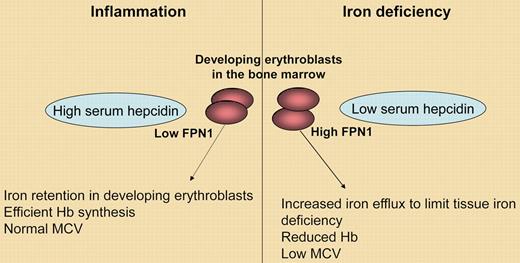In this issue of Blood, Zhang and colleagues propose the novel concept that when serum hepcidin is low, it increases ferroportin at the erythroblast membrane, thereby shutting down erythropoiesis when iron is scarce to favor its usage by cells sensitive to iron deprivation.1
Ferroportin 1 (FPN1), the only known iron exporter4 in mammalian cells, is highly expressed in macrophages, duodenal enterocytes, and hepatocytes. Hepcidin acts as an iron gatekeeper by regulating the amount of FPN1 present at the cell surface of target cells. The high serum hepcidin levels that are found when transferrin saturation or tissue iron stores are increased, or in inflammatory conditions, induce FPN1 internalization and degradation, thereby limiting iron availability. On the reverse, iron deficiency or expansion of the erythropoietic activity of the bone marrow will induce a drastic reduction in serum hepcidin levels and subsequent increase in FPN1, stimulation of intestinal iron absorption, and increased mobilization of iron stores.2
In macrophages, FPN1 is regulated at the transcriptional level by heme derived from phagocytosed red blood cells and at the translational level by iron released from heme by heme oxygenase.3 This posttranslational regulation is mediated by an iron regulatory element (IRE) present in the 5′ untranslated region (UTR) of the FPN1 mRNA. Iron regulatory proteins (IRPs), acting as intracellular iron sensors, will bind to this IRE in conditions of limited iron supply and repress mRNA translation. Iron entry into cells or release of iron from heme degradation will inactivate the IRPs and recruit FPN1 mRNA to the polyribosomes, thereby rapidly increasing FPN1 synthesis.4
Cianetti et al first identified a non-IRE FPN1 mRNA in human erythroblasts5 and Zhang et al subsequently identified the mouse FPN1B mRNA,6 generated by transcription from an upstream promoter and alternative splicing of the 5′ UTR. This FPN1B mRNA is also highly expressed in duodenum, escaping translational repression in conditions of iron deficiency.
Using the human erythroleukemia cell line K562 and cultured erythroid progenitors from mouse fetal liver, Zhang and colleagues show that FPN1B mRNA is highly expressed at the early stages of differentiation and that culturing the cells in the presence of hepcidin induces degradation of the FPN normally present at the cell surface of erythroblasts.1 The evidence that erythroblasts express an important amount of FPN at their membrane initially came as a surprise because these cells have a high iron demand to reach a sufficient rate of heme synthesis to allow hemoglobin formation. However, FPN1B is expressed at the early stages of differentiation, before the onset of high rate of heme and globin synthesis. This might be considered as a safety valve mechanism, allowing the erythroid progenitors to eliminate the iron incorporated in excess, to avoid its toxicity. A similar mechanism has already been proposed for the elimination of excess heme by FLVCR, a heme exporter. Inactivation of this gene induced early death of pro-erythroblasts, probably because of heme toxicity.7
Interestingly, Zhang et al propose the challenging hypothesis that in conditions of severe iron deficiency, the high FPN1 expression associated with low hepcidin levels would favor iron export from erythroblasts. In a way, these cells would “sacrifice” themselves for the benefit of other cells more sensitive to iron deprivation such as neurons or cardiomyocytes.1 The negative impact of hepcidin on erythroblast FPN1 would also account for an observation that has remained unexplained so far. In anemia of inflammation, iron-restricted erythropoiesis results form iron retention in macrophages, because of the high levels of serum hepcidin. However, the anemia is usually normocytic, suggesting that erythroid iron stores are sufficient to insure normal hemoglobin formation. Shutting down FPN1 expression at the erythroblast membrane could be one way of achieving this (see figure).
Role of the erythroblast FPN1-hepcidin interaction in pathologic conditions.
Role of the erythroblast FPN1-hepcidin interaction in pathologic conditions.
There are a number of unresolved issues concerning the role of FPN in erythropoiesis. First, there is some discrepancy regarding the subcellular localization of erythroblast FPN1, which has been found either intracellular5 or at the cell membrane.1 The demonstration that it can interact with plasma hepcidin is more in favor of a trafficking to the plasma membrane. Second, all the evidence provided so far has been obtained with cultured erythroid progenitors either from mouse fetal liver or from human circulating progenitors. In vivo, erythroid precursors proliferate, differentiate, and enucleate within the erythroblastic islands where they surround a central macrophage.8 Cell-cell and cell-extracellular matrix interactions play a major role in positive and negative regulatory feedback, and the FPN1-hepcidin interactions might operate very differently in this context than in vitro. Finally, from which pool is iron exported to the plasma? Ferritin must be degraded for iron to be exported by FPN19 and erythroblasts do not have high amounts of ferritin-associated iron. Alternately, iron available for export could also derive from iron released from heme degradation by heme oxygenase highly expressed at the early stages of differentiation, a mechanism reminiscent of the macrophage iron pathway. Iron exported by FPN1 could also derive from iron released into the cytosol after endocytosis of the Fe(III)-transferrin complex by transferrin receptors 1, to be eliminated only when taken up in excess of porphyrin availability. However, it is not clear whether this iron is directly targeted to the mitochondria or whether it transits by a cytosolic pool of labile Fe(II) iron. In favor of this direct mitochondrial targeting is the observation that the synthesis of ferritin subunits, encoded by IRE-containing mRNAs, is not stimulated during erythroid differentiation despite the high iron influx into these cells. If this is true, iron would not be available for export by FPN1.
Clearly, a precise analysis of the timing of onset of iron uptake, storage, and efflux during erythropoietic differentiation is required to get a better understanding of the role of this FPN1-hepcidin interaction and of its implications in pathologic situations.
Conflict-of-interest disclosure: The author declares no competing financial interests. ■


This feature is available to Subscribers Only
Sign In or Create an Account Close Modal